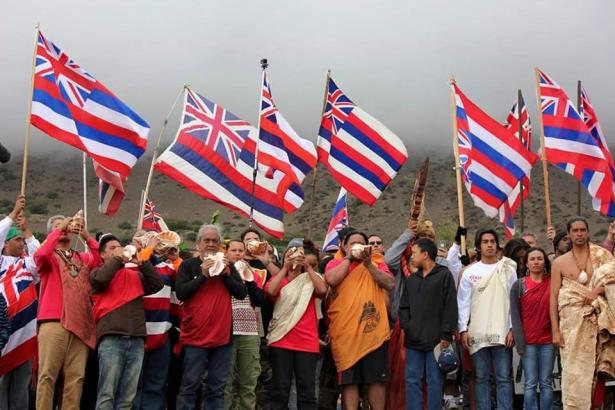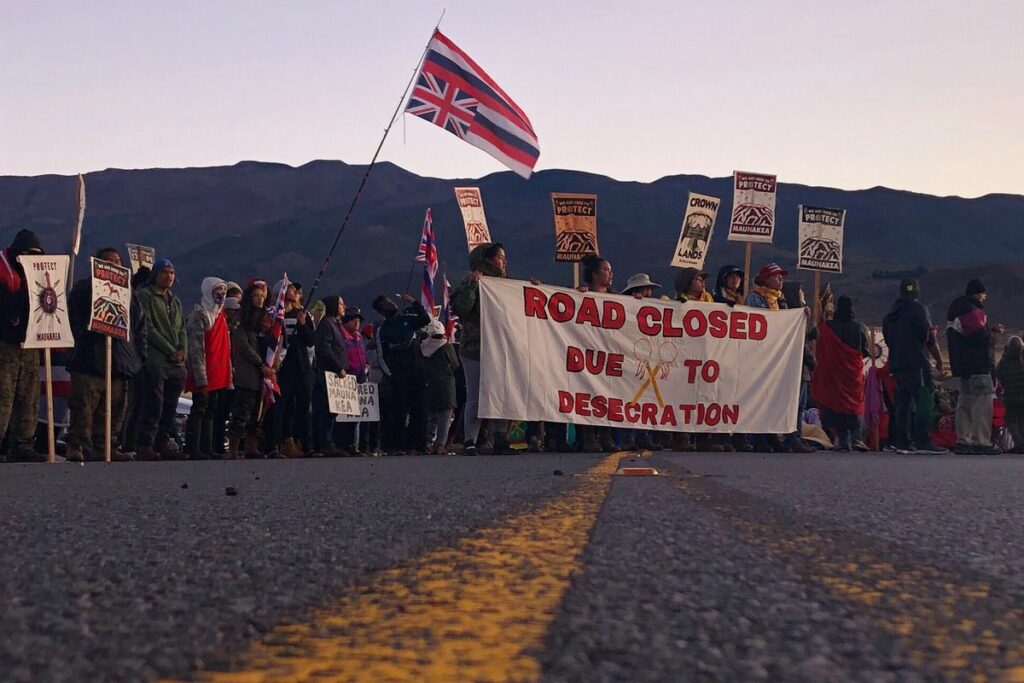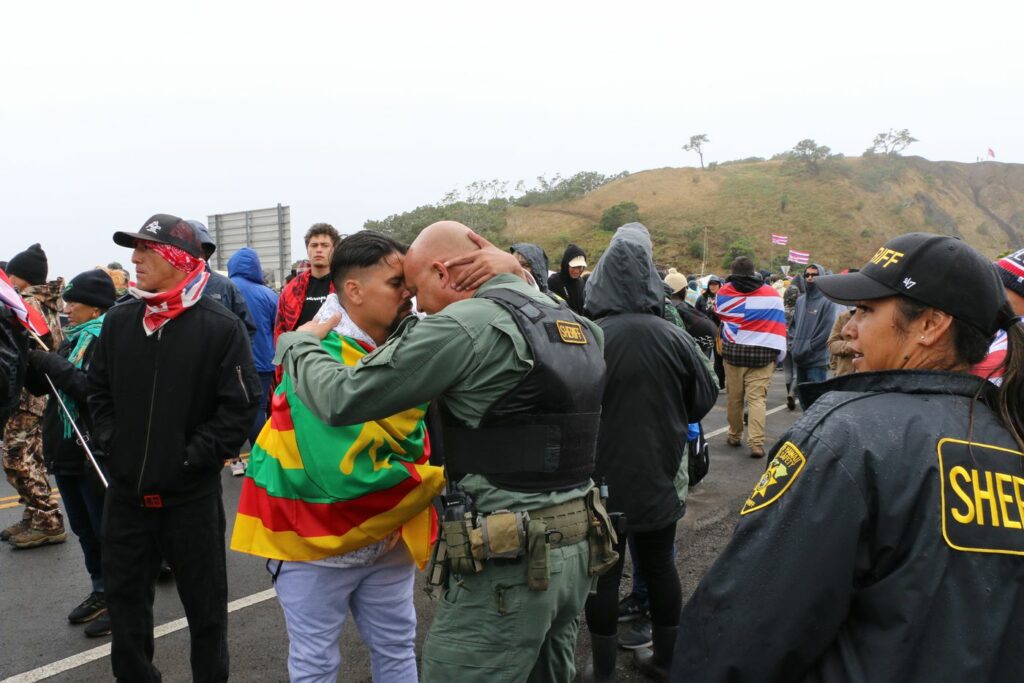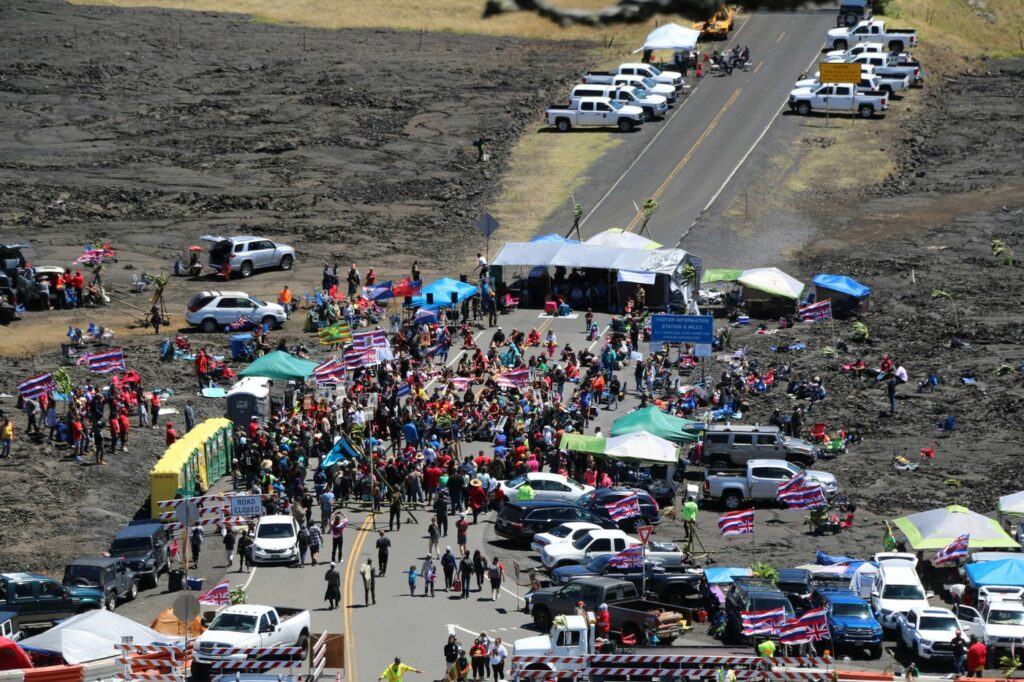Why Native Hawaiians Are Fighting to Protect Maunakea from a Telescope
ANGLO AMERICA, ASIA--PACIFIC, 12 Aug 2019
Trisha Kehaulani Watson-Sproat | Vox - TRANSCEND Media Service
Pundits have said the Native Hawaiian resistance to the Thirty Meter Telescope project is a conflict between science and culture. But the protectors are not against science; they just believe the telescope does not belong on Maunakea’s sacred lands. The mountain is among the most sacred sites in Hawaiian cosmology.

Maunakea protectors blow the Pū or conch shell to mark the ceremonial beginning of their protest to halt construction of the giant telescope. We Are Mauna Kea/ Facebook
3 Aug 2019 – On the morning of July 15 — the day Hawaii Gov. David Ige said construction would begin for the controversial Thirty Meter Telescope (TMT) project on the Big Island — a line of elders, known as kūpuna, positioned themselves in the roadway leading up to the summit of Maunakea. Each elder was assigned a caretaker to tend to their health and nutritional needs while they awaited and blocked access to the construction trucks. Farther up the road, a group of seven Native Hawaiian protectors chained themselves to a cattle guard as a second line of defense in case law enforcement arrested the kūpuna.
The group’s first and second days on Maunakea, among the most sacred sites in Hawaiian cosmology, ended without incident. But arrests began on the morning of July 17. Despite pleas from younger activists to protect the kūpuna, the elders insisted on remaining on the front line and being the first arrested, asking the younger protectors to stand down and remain silent while they were taken.
Some elders forced officers to physically remove them, and they were picked up and carried down the road. Some were wheeled off in their wheelchairs. Others walked, sometimes with the help of walkers, if they could. Many of the 35 arrested were in their 70s or 80s.
The younger protectors openly wept and prayed as the kūpuna were taken in custody. Law enforcement, most of them Hawaiians themselves, moved slowly and respectfully, looking pained and conflicted as they arrested the kūpuna. The interaction remained peaceful, but the heartbreak was palpable.
“This is all we have left, so we aren’t going to move,” said veteran activist Walter Ritte, who was one of the kūpuna arrested. “They’re going to have to keep arresting us — and we’ll keep coming right back. The mountain represents us, all Hawaiians, so we’re not going to let them take our mountain. … We aren’t going to leave her.”
The legal fight over Maunakea has been more than 10 years in the making, with the Hawaii Supreme Court ruling in 2018 that construction for TMT can proceed. But even with legal consent, the company behind the telescope has said “if it keeps encountering obstacles” in Hawaii, it would be “happy” to move the project to La Palma, Spain.
The protectors, or kia’i, are intent on being those obstacles. Bolstered by supporters across the state and country, the protests over Maunakea have become one of the largest uprisings of Native Hawaiians in modern history.

Native Hawaiians gather to protect Maunakea from the construction of the Thirty Meter Telescope.
Caleb Jones/AP
Protectors descended on Maunakea to protect it from construction
On July 10, Ige announced the TMT project would begin construction on Maunakea on July 15. The current project, led by the University of California and significantly funded by the Gordon and Betty Moore Foundation (the former is a co-founder of Intel), garnered substantial opposition from Hawaii residents throughout its development, and particularly from Native Hawaiians, who consider the site sacred. (Native Hawaiians are lineal descendants of those who inhabited Hawaii prior to the arrival of foreigners in 1778, whereas “Hawaii residents” refers to people who reside in Hawaii but are not of native descent.)
In addition to fragile natural resources, the mountain contains numerous cultural resources and historical and burial sites.
By July 13, the kia’i of Maunakea had mobilized at Pu’u Huluhulu, a small hill located at the base of the Maunakea access road. They opened with a traditional ceremony and declared the area a refuge (pu’uhonua) for any and all who sought to join them. The number of supporters in the sanctuary started at 500 the first day and swelled to approximately 2,000 by the end of the week.
Among the 35 elders arrested on that third day of protection were some of the most respected in the community: 82-year-old Kumu Hula Pua Kanaka’ole Kanahele, daughter of Edith Kanaka’ole, for whom Edith Kanaka’ole Stadium, home of the Merrie Monarch Hula Festival, is named; 68-year-old attorney Mililani Trask, sister of the famed author and activist Haunani-Kay Trask; retired nurse Genevieve Kinney, who at 85 years old needed to be taken into custody in her wheelchair; and Ritte, a well-known activist and member of the “Kaho’olawe Nine,” along with his wife, former Miss Hawaii Loretta Ritte.
Based on footage released by the state, law enforcement officers, many Hawaiians and some related to kia’i, continue to struggle emotionally with being forced to stand opposite to the Hawaiian community gathered at the mountain. The use of Native Hawaiian law enforcement has been met with harsh criticism. Many consider it an intentional decision by government leaders, who are primarily non-Hawaiian, to create division and trauma within the Hawaiian community.

Big Island law enforcement, many of them Hawaiians themselves, looked pained and conflicted as they interacted with protectors. Dan Dennison/AP
The arrests and continued threat of force against the protectors opened floodgates of anguish and outrage across the state and country. Immediately, Hawaiians and allies began to take to the streets.
Led largely by Kumu Hula (cultural practitioners and Hawaiian dance masters), Hawaiians and supporters began to occupy government buildings and offices. The H-1 on the neighboring island of Oahu was slowed to a near halt as more than 100 supporters in vehicles took control of traffic on the busy freeway. Additional demonstrations spontaneously took place at the airport and other locations across the state.
https://www.instagram.com/p/Bz9i8bPHc8V/?utm_source=ig_embed
Demonstrations also began to pop up organically across the country, as 250,000 Native Hawaiians live on the continental United States. Hundreds of Hawaiians and supporters held events in California, Utah, New York, Texas, Nevada, Michigan, Oregon, and Washington.
On Sunday, more than 1,000 Hawaiians and supporters took to the streets in Waikiki while thousands of other groups demonstrated on beaches and elsewhere across the state. Organized by musicians, Kumu Hula, and educators, the events showed the growing support the kia’i have in a broad sector of the community.
For Hawaiians, the fight is not about science. It’s about aloha ’āina.
According to its website, “The Thirty Meter Telescope International Observatory (TIO) seeks to advance scientific knowledge while fostering connection among the partner countries and their citizens, who represent over half the world’s population.” Many commenting on the situation have categorized it as a conflict between science and culture.
When asked, the protectors will quickly explain they are not against science and have little opposition to the TMT project itself — they just firmly believe it does not belong on the sacred lands of Maunakea. (Maunakea is a proper noun; Mauna Kea, another common spelling, is a reference to any white mountain.)
Maunakea is considered an origin of Hawaiian cosmology, a Hawaiian equivalent to Christianity’s Garden of Eden. It is the meeting place of Earth Mother, Papahānaumoku, and Sky Father, Wākea. In turn, Maunakea is considered a piko, center, of the Hawaiian universe.
Kumu Hula Kawaikapuokalani Hewett is one of Hawaiian music’s most prolific songwriters, cultural practitioners, and a lineal descendant of the mountain, having penned many songs inspired by and for Maunakea. “My kuleana (responsibility) is to write, to educate. My kuleana is to give honor to my ancestors,” he explains from his home on the Big Island. “This whole movement is remarkable that all the Hawaiian people are coming together, and rightfully so because this is their very genealogy. We all descend from the piko of Wākea.”
Inseparable from Hawaiian culture is a love of the land, ’āina. For Hawaiians — who thrived in the islands before foreigners arrived at the end of the 18th century — care and attachment to the land is central to their identities. The term “aloha ’āina,” literally meaning love of the land, has long been a rallying cry for Hawaiians.
https://www.instagram.com/p/Bz-2KUaF7SF/?utm_source=ig_embed
TMT, which would become the largest telescope in the Northern Hemisphere, would significantly increase the footprint of activities on the summit of Maunakea. Cultural practitioners and environmentalists have numerous concerns about the impact the facility would have on natural resources. According to the final environmental impact statement, the facility would regularly store large amounts of domestic and chemical waste on site prior to removal.
The greatest concern among protectors is the impact the project will have on cultural resources. The environmental impact statement clearly states: “From a cumulative perspective, the impact of past and present actions on cultural, archaeological, and historic resources is substantial, significant, and adverse; these impacts would continue to be substantial, significant, and adverse with the consideration of the Project and other reasonably foreseeable future actions.”
TMT proponents claim that because there are no historic structures within the project area, cultural resources will not be as severely affected. Yet they fail to understand that built historic structures are not a prerequisite for cultural significance. People across the world are inspired daily by rainbows they will never touch; they bask in the spiritual calm of sunsets, even though they will never set foot on the sun. To Native Hawaiians, the spiritual and cultural significance of Maunakea is intrinsically tied to its majestic landscape that will be forever altered by the project.
From ceded lands to telescopes: how the project ended up on Maunakea
The project area is located on “ceded lands,” which were part of the crown lands of the Hawaiian monarchy until US leaders overthrew Queen Lili’oukalani and ceded the lands to the federal government. After statehood, the lands were turned over to Hawaii, and it was required to hold these lands in trust for specific purposes, including “betterment of the conditions of Native Hawaiians,” under the 1959 Statehood Act.
In 1964, the state issued a lease to the University of Hawaii for 13,321 acres of ceded lands at the summit of Maunakea for $1 per year. The university was authorized to build “an observatory” but proceeded to build multiple observatories without prior approval, a violation of the lease.
Many Native Hawaiians consider these lands part of the inventory of resources illegally taken from them by the United States and view the state as only temporary stewards of these crown lands. In the 1960s and ’70s, public concern grew over the poorly regulated development at the summit. In 1974, then-Gov. George Ariyoshi required the Department of Land and Natural Resources to develop a master plan for the area. He noted, “I am concerned that social pressures for more intensive use of the Mauna Kea for scientific, recreational and other purposes pose a threat to the priceless qualities of the mountain.” There were only three observatories on Maunakea at that time. Today, there are 13 telescopes at the summit — TMT would be the 14th.
Environmental groups like the Audubon Society and the Sierra Club, along with Native Hawaiians, continually fought to stop the development of observatories and require the state and university to better manage the area’s resources. In 1995, the Sierra Club forced the university to airlift large amounts of accumulated waste from the mountain. In 1998, the first of numerous state audits was released documenting the poor management of the area’s natural resources by the state and university.
The environmental groups also won numerous legal battles, like when practitioners had the project’s first effort to obtain a Conservation District Use Permit overturned by the Hawaii Supreme Court in 2015. The state was forced to revisit the permit, which again met heated opposition from practitioners and the community. Over the next three years, the project, state, and community battled over the issuance of the permit, until the practitioners finally exhausted all legal remedies last year and the state Supreme Court allowed the project’s second attempt to obtain the necessary permit to stand.

Over the course of a week, the number of protectors on Maunakea grew from around 500 to nearly 2,000. Dan Dennison/AP
Many were outraged by the decision as they consider the extremely fragile ecosystem — which is supposed to be protected by conservation laws — an inappropriate location for the structures, the largest of which will reach 180 feet, or more than 12 stories high. The state argued that mitigation efforts and conditions of the permit were sufficient to compensate for the damage the project would do, but opponents disagreed, citing the state audits — in 1998, 2005, 2014, and 2017 — that demonstrated the mismanagement of the resources. Others noted how the project reflects the privilege of the Western scientific community, which appears willing to bulldoze over any culture in furtherance of its wants.
Hawaiians and conservationists found the decision especially disrespectful considering TMT identified alternative sites it defined as “excellent for carrying out the core science of the TMT.” In October 2016, the TMT selected Observatorio del Roque de Los Muchachos in La Palma, Spain, as the official alternate site. As recently as 2017, TMT signed a 75-year hosting agreement and completed an environmental impact assessment for the site. Despite having Spain as a willing partner, TMT has continued to push forward with the Maunakea site.
Hawaii’s past has become precedent
The kia’i, many but not all Hawaiian, explain that the response to this controversy extends far back into Hawaii’s colonial history. The state’s actions, and particularly the manner in which the state has disregarded and dehumanized Native Hawaiians, are part of a long continuum of abuse and settler violence against a people who have long been peaceful toward the outside world.
“The opposition to the TMT construction is like the straw that broke the camel’s back,” explained Randall Akee, an associate professor of public policy and American Indian studies at UCLA and a David Rubenstein fellow in Economic Studies at the Brookings Institution. “It represents decades of poor management of Hawaii’s natural resources and prioritizing of economic interests ahead of community interests. As a result, Native Hawaiians are turning out in droves to oppose TMT. We see a similar thing going on, initiated due to different reasons, in Puerto Rico right now with respect to another governor who has been deaf to the pleas and concerns of their population. The history of colonization, however, links the two island archipelagos.”
Hawaii had long been a tinderbox of colonial tensions; Maunakea simply lit the flame. Hawaiians began organizing in the 1970s to combat the institutionalized racism and prejudice they had been subjected to for generations. The movement to regain control of their lands and resources only grew from there, as Hawaiians retaught themselves their language and restored their cultural practices on a mass level, which had been largely outlawed and condemned by the provisional and territorial governments after the overthrow.
The result of the modern Hawaiian rights movement is a population of Hawaiians and allies who are educated, conscious of, and combating settler colonialism and its influence in Hawaii, and ready to regain control of their lands, their resources, and their government.
However, the state is refusing to back down.
Nearly 100 police officers have already been flown in from neighboring counties to reinforce existing law enforcement on the Big Island. On July 17, the same day arrests began, Gov. Ige issued an emergency proclamation “to protect the health, safety, and welfare of the people on Hawai’i Island and across the State of Hawai’i, to also ensure the execution of the law, prevent lawless violence, and the obstruction of the execution of the law.” The emergency proclamation grants the governor additional police powers and the authority to call in the National Guard.
Hawaiians viewed issuance of the emergency proclamation and the growing threat of police force against them as a demonstration of how little has changed in Hawaii over the past 126 years.
The unfolding events are eerily reminiscent of the events of 1893, when American and European foreigners living in Hawaii fabricated safety concerns so American military forces could land on the sovereign kingdom of Hawaii soil and aid in the coup that would allow a “union with the United States.” On January 16, 1893, the self-appointed “Committee of Safety” wrote a letter to US Minister to Hawaii John L. Stevens claiming that “the lives and property of the people were in peril and appealing to him the United States forces at his command for assistance.”
The next day, on January 17, 1893, armed troops, who had landed without permission from the sovereign nation, forced Queen Lili’uokalani to yield her authority to the United States. The Committee of Safety named themselves the acting provisional government.

On Jan. 17, 1893, Hawaii’s monarchy was overthrown when a group of businessmen and sugar planters forced Queen Liliuokalani to abdicate.
The United States refused to return the queen her authority, and within 10 years, Hawaii was annexed to the United States under a joint resolution of Congress when efforts to pass a treaty of annexation failed.
Since Americans seized control of Hawaii, Native Hawaiians have been subject to ongoing prejudice and discrimination. Land was systemically stripped from the native people over the next century. Studies have shown how racial prejudice has infiltrated the judicial system, where Native Hawaiians often receive longer and harsher sentences than their non-Hawaiian counterparts. Hawaiians continue to receive lower wages and struggle economically, even in their own homeland.
For now, the state stands ready to call in the National Guard to assist the construction of the TMT. The Honolulu Star-Advertiser reported on Saturday that Jason Redulla, chief of the state Department of Land and Natural Resources’ Division of Conservation and Resources Enforcement (DOCARE), confirmed that the Army’s 100th Battalion/442nd Infantry Regiment “has arrived in Hawaii County.” There are 80 National Guard members currently stationed at or near the campsite.
The protectors have been on high alert, anticipating that armed forces will begin raids on the camp in the coming days. They also fear the use of a long-range acoustic device (LRAD) as a weapon, which was purchased by the Hawaii Division of Conservation and Resource Enforcement in recent months. LRADs have been used against peaceful protests in New York, Washington, DC, and Ferguson, Missouri. A year ago, the Second Circuit Federal Court of Appeals upheld a decision out of the Southern District of New York that found that the apparatus was not simply a “communication device,” as the New York Police Department claimed, but rather a potential instrument of excessive force.
The truth about the protectors versus government spin
It is estimated that the camp area now includes 2 miles of highway along the Daniel K. Inouye Highway, locally known as Saddle Road. The pu’uhonua is highly organized, with each new occupant undergoing an orientation upon arrival. Among the rules are no drugs, no smoking of any kind, no alcohol, and no weapons. Occupants are also required to hold themselves in “kapu aloha,” a spiritual edict of restraint and self-control where one acts only with compassion, love, and care for others.
Security, organized and run by the kia’i and the Royal Order of Kamehameha, is present 24 hours a day. There are 32 portable toilets that are pumped twice daily. All materials are sorted and recycled when possible. Trash is removed daily. There is a highly organized food service that feeds all present.
Despite the overwhelming evidence of the safety and order present in the refuge, including photos and video footage widely circulated on social media and local news, the state and project proponents continue a well-funded campaign of misinformation that aims to undermine the credibility of the protectors.
Ige went so far as to call the camp an “unsafe situation” that justified the use of his emergency powers. He also expressed concerns over “reports of drugs and alcohol use.” The response from kia’i and their supporters was fast and fierce. Armed with visual evidence of the refuge’s safety, many people called the governor a “liar.” The leaders of the refuge have publicly announced that they will not meet with him until he issues a public apology. Ige has not responded to Vox’s request for comment.
It is unclear to all where the governor is getting his information, as he has refused to visit the refuge himself despite numerous public invitations by the protectors. Many were baffled by his decision to fly to the Big Island to give a press conference on July 19 while refusing to visit the actual campsite. He offered no evidence or firsthand knowledge for his public accusations about the kia’i.
Ige and his administration are also quickly losing support among local elected officials. His own lieutenant governor, Josh Green, a Big Island physician seen as a champion of humanitarian causes, has publicly cautioned the governor against the use of the National Guard and even visited the pu’uhonua on July 22, meeting with leaders and taking medical supplies to the camp. Similar statements, appearing to back away from the governor’s position, were issued by federal, state, and county leaders.
Groups like the American Civil Liberties Union and Amnesty International have also already issued statements warning the state to deescalate the conflict, as increased force may pose real threats to the rights of Hawaiians and other protectors peacefully exercising their rights to nonviolent resistance.
Similarly, a petition calling for Ige’s removal continues to gain supporters online and currently has more than 43,000 signatures. Another petition, calling for the immediate halt of construction on Maunakea and directed to TMT partners and funders, garnered more than 157,000 signatures in a single week. University of Hawaii faculty are also calling for the removal of university president David Lassner, unhappy with his leadership throughout this ordeal.
With more and more supporters arriving at the camp daily, it is becoming clear that construction on Maunakea will not take place short of a significant and aggressive police action against the peaceful demonstrators. Yet with each step toward increased militarized force, the resistance to the state and the project grows.
For a project that claims to be for the benefit of mankind, TMT is quickly becoming synonymous with human rights violations, excessive police force, and a misinformation campaign that embodies all the worst acts of trauma against indigenous peoples. The protectors, bearing only aloha and compassion, are becoming a symbol of peaceful resistance and steadfast commitment to restoring indigenous self-determination.
As musician and protector Kawaikapuokalani Hewett thoughtfully notes, “We are not fighting just for the Hawaiian people; we are fighting for the natural resources for all future generations. Our future is tied into everyone’s future. If you think this isn’t about you, think again, it’s about everybody.”
_____________________________________________________
Trisha Kehaulani Watson-Sproat was born and raised on the island of O‘ahu, to which she has long ancestral ties. She currently runs Honua Consulting, which focuses on environmental planning and cultural resource management in Hawai’i. She is vice president of ‘Āina Momona, the nonprofit organization founded by famed activist Walter Ritte, and she is president of the Kalihi Pālama Culture & Arts Society, a community organization that promotes hula and cultural activities throughout Hawai’i. You can find her on twitter at @hehawaiiau.
Tags: Activism, Asia and the Pacific, Conflict, Culture, Development, Environment, Hawaiian Culture, Hawaiian Religion, History, Human Rights, Indigenous Rights, Justice, Nonviolence, Occupation, Politics, Power, Racism, Religion, Social justice, Solutions, USA, Violence, West
DISCLAIMER: The statements, views and opinions expressed in pieces republished here are solely those of the authors and do not necessarily represent those of TMS. In accordance with title 17 U.S.C. section 107, this material is distributed without profit to those who have expressed a prior interest in receiving the included information for research and educational purposes. TMS has no affiliation whatsoever with the originator of this article nor is TMS endorsed or sponsored by the originator. “GO TO ORIGINAL” links are provided as a convenience to our readers and allow for verification of authenticity. However, as originating pages are often updated by their originating host sites, the versions posted may not match the versions our readers view when clicking the “GO TO ORIGINAL” links. This site contains copyrighted material the use of which has not always been specifically authorized by the copyright owner. We are making such material available in our efforts to advance understanding of environmental, political, human rights, economic, democracy, scientific, and social justice issues, etc. We believe this constitutes a ‘fair use’ of any such copyrighted material as provided for in section 107 of the US Copyright Law. In accordance with Title 17 U.S.C. Section 107, the material on this site is distributed without profit to those who have expressed a prior interest in receiving the included information for research and educational purposes. For more information go to: http://www.law.cornell.edu/uscode/17/107.shtml. If you wish to use copyrighted material from this site for purposes of your own that go beyond ‘fair use’, you must obtain permission from the copyright owner.
Read more
Click here to go to the current weekly digest or pick another article:
ANGLO AMERICA:
ASIA--PACIFIC: